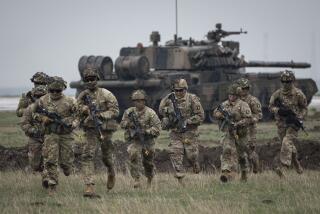NATO to Offer Plan for Cuts in Warplanes
BUDAPEST, Hungary — In an effort to accelerate negotiations, the United States and its Western allies will offer the Soviet Bloc a specific proposal today to reduce warplanes in Europe to 5,700 aircraft and 1,900 helicopters on each side, Secretary of State James A. Baker III announced Wednesday.
The proposal, which will be made formally at the Vienna negotiations to reduce conventional forces in Europe, was devised by the 16 NATO countries after the alliance’s agreement in May to seek an early agreement at the talks. Bush Administration officials said it is intended to “keep the pressure on” the Soviet Union in the negotiations.
Like earlier proposals for drastic cuts in tanks, artillery and other conventional ground weapons, the new offer requires highly unequal reductions for NATO and the Warsaw Pact. The 5,700 ceiling for aircraft, for example, will be 15% below NATO levels but about 60% below Warsaw Pact levels, as aircraft are counted by the United States and its allies.
More surprising was that NATO’s latest figures were considerably higher than earlier aircraft totals, suggesting that its inventory is being increased in order to minimize the impact of future reductions.
In January, 1988, for example, NATO reported 5,036 aircraft in its inventory. Recently, the U.S. Air Force deputy chief of staff, Gen. Robert Herres, told Congress that NATO had 5,400 aircraft. Now, Baker’s ceiling of 5,700--which would apply after 15% reductions--suggests an inventory of about 6,500 planes.
Improving Base Figure
“(NATO) is trying to make its base figure as large as possible so when cuts are taken, they can come from marginal equipment, such as trainers, stored aircraft and older models,” according to Jack Mendelsohn, deputy director of the nonprofit Arms Control Assn.
To get this figure, Mendelsohn added, “they might be forecasting the transfer of several hundred U.S. FB-111s and F-15Es,” by the time any agreement takes effect. Other NATO nations may plan similar transfers to raise the totals.
The disparities between NATO and the Warsaw Pact on helicopters are less severe but still considerable. However, as with fixed-wing aircraft, the two sides are counting different types of equipment to get their starting totals. These differing definitions are expected to be very difficult to resolve during the negotiations.
In announcing the new NATO proposal for the talks on conventional forces, Baker said it proved the Administration’s determination to speed up the talks that have been under way in Vienna since March.
“The Soviets (said) that the Administration was slow in getting its arms control act together,” Baker said. “I think we’ve proven that that was wrong.”
Baker, who is accompanying Bush on a four-nation tour of Europe, said NATO’s quick agreement on the plan showed that the President’s call for a treaty to be concluded within one year “was not unreasonable.”
“By tabling this new proposal, we are taking a step toward ending the military division of Europe,” Baker said.
The proposal follows the basic lines proposed by Bush and agreed to by NATO in May. It had not been expected to be formally presented to the Soviet Bloc until Sept. 6, when the talks resume after an August recess.
NATO has thus speeded up the offer by about two months, and a White House official said the quick formalization of the May proposal means that detailed negotiations could begin in earnest in Vienna this fall.
“There’s no doubt that conceptually, the two sides are now closer than they’ve ever been in the history of conventional arms control,” the official said. “They’ve agreed on the number of weapons that are there, the kinds of weapons to reduce and where to reduce them.”
At the same time, he noted, deep differences remain between the two military alliances over many of the details of conventional arms reduction--notably, over the same issue of combat aircraft that the NATO proposal addresses.
The Soviet Union contends that much of its large fleet of fighter airplanes should not be subject to negotiated cuts. Moscow contends that the fighters are defensive weapons, because they are equipped only to fight other airplanes, not to attack territory. It also wants to exclude combat-capable training planes.
But NATO insists that all Soviet Bloc planes capable of combat should be part of the talks, arguing that it is impossible to distinguish between offensive and defensive aircraft, particularly since the so-called interceptors train in ground-attack roles.
“Our view is that if it can fly and shoot, it’s a combat aircraft,” the White House official said. “Many of their so-called air defense planes can quickly change to air-to-ground-attack planes. And they can also defend air bases, which are used to launch offensive actions.”
Dispute Over Numbers
The difference in definition produces a significant disagreement over how many Soviet Bloc planes should be removed from service as part of a conventional pact. NATO estimates that the Warsaw Pact has about 14,500 combat aircraft, for example, of which more than 4,000 are air defense interceptors and 5,700 are combat-capable trainers.
Using its definition, the Soviets claim to have only 2,780 “attack” aircraft and propose cuts to 1,500, compared to the 5,700 NATO offer using its definitions.
On helicopters, the two sides are relatively close in the ceilings they seek. NATO proposes a limit of 1,900, the Warsaw Pact has proposed a total of 1,700. But again, problems of definition are significant, with NATO seeking to count only attack-assault craft while the Warsaw Pact proposal would cover anti-submarine and other naval helicopters. NATO says it has only 2,600 helicopters by its count, for example, while the Warsaw Bloc claims that NATO has more than 5,200.
The NATO proposal also restates the Western position on other types of conventional arms: major reductions in tanks, armored vehicles and artillery, coupled with a cut in both U.S. and Soviet troops in Europe to 275,000 each.
McManus reported from Budapest and Toth from Washington.
More to Read
Sign up for Essential California
The most important California stories and recommendations in your inbox every morning.
You may occasionally receive promotional content from the Los Angeles Times.











